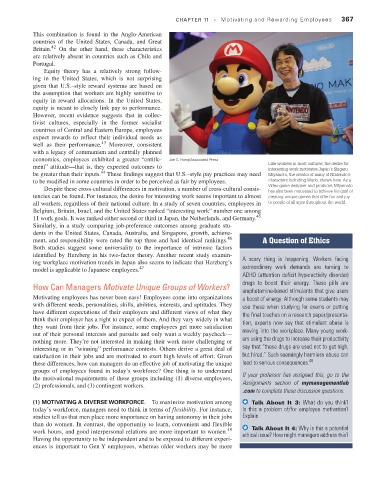Page 368 - Fundamentals of Management Myths Debunked (2017)_Flat
P. 368
This combination is found in the Anglo-American CHAPTER 11 • Motivating and Rewarding Employees 367
countries of the United States, Canada, and Great
42
Britain. On the other hand, these characteristics
are relatively absent in countries such as Chile and
Portugal.
Equity theory has a relatively strong follow-
ing in the United States, which is not surprising
given that U.S.–style reward systems are based on
the assumption that workers are highly sensitive to
equity in reward allocations. In the United States,
equity is meant to closely link pay to performance.
However, recent evidence suggests that in collec-
tivist cultures, especially in the former socialist
countries of Central and Eastern Europe, employees
expect rewards to reflect their individual needs as
43
well as their performance. Moreover, consistent
with a legacy of communism and centrally planned
economies, employees exhibited a greater “entitle- Jae C. Hong/Associated Press
ment” attitude—that is, they expected outcomes to Like workers in most cultures, the desire for
interesting work motivates Japan’s Shigeru
44
be greater than their inputs. These findings suggest that U.S.–style pay practices may need Miyamoto, the creator of many of Nintendo’s
to be modified in some countries in order to be perceived as fair by employees. characters including Mario, shown here. As a
Despite these cross-cultural differences in motivation, a number of cross-cultural consis- video game designer and producer, Miyamoto
has also been motivated to achieve his goal of
tencies can be found. For instance, the desire for interesting work seems important to almost creating unique games that offer fun and joy
all workers, regardless of their national culture. In a study of seven countries, employees in to people of all ages throughout the world.
Belgium, Britain, Israel, and the United States ranked “interesting work” number one among
45
11 work goals. It was ranked either second or third in Japan, the Netherlands, and Germany.
Similarly, in a study comparing job-preference outcomes among graduate stu-
dents in the United States, Canada, Australia, and Singapore, growth, achieve-
46
ment, and responsibility were rated the top three and had identical rankings. A Question of Ethics
Both studies suggest some universality to the importance of intrinsic factors
identified by Herzberg in his two-factor theory. Another recent study examin-
ing workplace motivation trends in Japan also seems to indicate that Herzberg’s A scary thing is happening. Workers facing
model is applicable to Japanese employees. 47 extraordinary work demands are turning to
ADHD (attention deficit hyperactivity disorder)
How Can Managers Motivate Unique Groups of Workers? drugs to boost their energy. These pills are
amphetamine-based stimulants that give users
Motivating employees has never been easy! Employees come into organizations a boost of energy. Although some students may
with different needs, personalities, skills, abilities, interests, and aptitudes. They use these when studying for exams or putting
have different expectations of their employers and different views of what they the final touches on a research paper/presenta-
think their employer has a right to expect of them. And they vary widely in what tion, experts now say that stimulant abuse is
they want from their jobs. For instance, some employees get more satisfaction
out of their personal interests and pursuits and only want a weekly paycheck— moving into the workplace. Many young work-
nothing more. They’re not interested in making their work more challenging or ers using the drugs to increase their productivity
interesting or in “winning” performance contests. Others derive a great deal of say that “these drugs are used not to get high,
satisfaction in their jobs and are motivated to exert high levels of effort. Given but hired.” Such seemingly harmless abuse can
these differences, how can managers do an effective job of motivating the unique lead to serious consequences. 48
groups of employees found in today’s workforce? One thing is to understand
the motivational requirements of these groups including (1) diverse employees, If your professor has assigned this, go to the
(2) professionals, and (3) contingent workers. Assignments section of mymanagementlab
.com to complete these discussion questions.
(1) Motivating a Diverse Workforce. To maximize motivation among Talk About It 3: What do you think?
today’s workforce, managers need to think in terms of flexibility. For instance, Is this a problem of/for employee motivation?
studies tell us that men place more importance on having autonomy in their jobs Explain.
than do women. In contrast, the opportunity to learn, convenient and flexible
Talk About It 4: Why is this a potential
49
work hours, and good interpersonal relations are more important to women. ethical issue? How might managers address this?
Having the opportunity to be independent and to be exposed to different experi-
ences is important to Gen Y employees, whereas older workers may be more

